Friends Charlene and Richard in Forest Grove let me sleep in their Garden while I was attending Aikido Summer Camp. They have converted their one-acre suburban lot into a beautiful permaculture garden and food forest that not only feeds them (and a local Latino family that uses part of it for their own market garden), but has also given them the means to develop an interesting educational program. They had talked to me about teaching spoon carving up there, so one evening they showed me their collection of spoons and kitchen utensils. One jar of spoons they had gotten from a friend who had traveled the world collecting beautiful things. The spoons all showed native craftsmanship that combined beauty and function — but one in particular I just fell completely in love with. Fortunately for me, their collection is big enough that they were willing to trade. Below are some photos of my favorite, as well as notes and an attempt to understand why I like it so much.
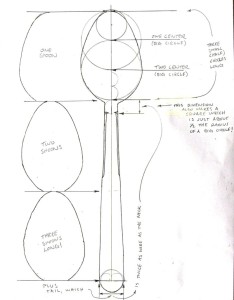
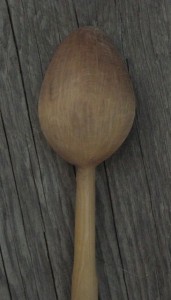
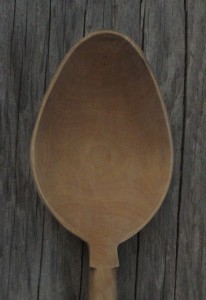
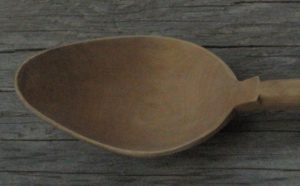

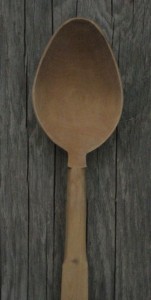
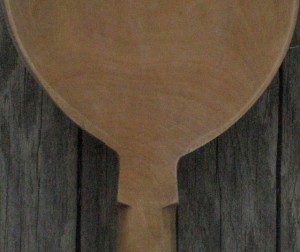
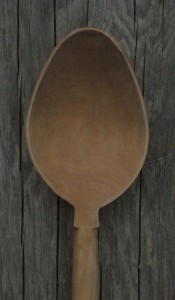
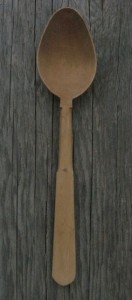
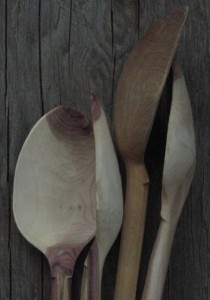
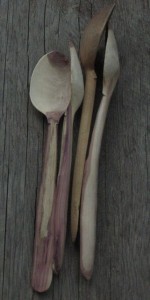
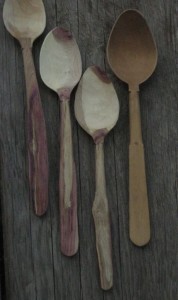
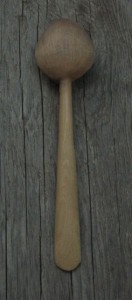 Click on the drawing or photo for a higher resolution file. The drawing should be pretty self-explanatory — I did it to better understand why I like this spoon so much. Design, to my mind, is not prescriptive but intuitive. If all we know (or teach, or learn) of design comes from drawings and measurements, we’ll never learn to see or trust those relationships that just work, naturally. But when you find something that does work, naturally, it can help to examine (and even copy!) it analytically (more stories along these lines here).
Click on the drawing or photo for a higher resolution file. The drawing should be pretty self-explanatory — I did it to better understand why I like this spoon so much. Design, to my mind, is not prescriptive but intuitive. If all we know (or teach, or learn) of design comes from drawings and measurements, we’ll never learn to see or trust those relationships that just work, naturally. But when you find something that does work, naturally, it can help to examine (and even copy!) it analytically (more stories along these lines here).
This spoon appears to have been carved from a piece of branch wood roughly the same width as the bowl of the spoon. Charlene suggested it was boxwood: fine-grained, tight growth rings, and hard. It appears to have been finished by scraping — up close, you can see the long parallel faces that are too regular to have been carved, and too well- defined to have been sanded.
It’s a big spoon, but it’s easy and comfortable to eat with. Below I photographed it with my first attempts at copying, which are made of Lilac — not so deep, and not so nice.
Nice drawing. It will help me much. What is the significance of the “Latino” in the family that shares the garden?
Interesting question; that the family sharing the garden was Latino is just the very tip of a story I know only in bits and pieces — and that I don’t feel fully qualified to report on — but thanks for the question, because it warrants more space than I gave it. The biggest bit is that the Latino community make up a very significant part of the ag economy in OR. Part of what Charlene and Richard have undertaken, on their own as well as through their work with Foodways at Nana Cardoon is helping to make more and better connections between the (largely white and affluent) foodie community and the people who are actually working in the fields and putting food on our tables (often low-income and of color). Food can build bridges, on foundations laid at a shared table… (here’s a good story along the same lines.)
Thank you for posting – this is a nice functional design. When we are new to something it is helpful to see your sketch so we know why it works – thanks again
What hooked knife do you recommend for carving spoons?
Thanks!
I have bought good knives from both Kestrel Tools in WA, and Del Stubbs’ Pine Woods forge in MN. Kestrel’s knives are NW native style with a double-edge, so you have choice of more different grips to use, but the bevel is on the top of the curve, which means they tend to chatter when cutting a tight curve. Del’s knives are beveled on the back and have a tighter turning radius, but they’re single-edged, which means less options for grips and directions of work. My favorite knife is one I made myself — double-edged, with the bevel on the back for a tighter turning radius. Kestrel sells blanks and directions for making your own. There are many other good knives on the market that I haven’t bought…
I really like this design, going to take the pattern and try to replicate it myself. Thank you for sharing.
you’re welcome! send a photo of your spoon!
BeAutiful spoons! I would love to makes spoon or two or four! Thank you for sharing !
I. Have been a wood carve for over 30 years but am new to spoon carving, not too sure why why but I am loving it. Thank you for the photos and diagrams! The spoon design looks graceful and balanced. Beautiful!